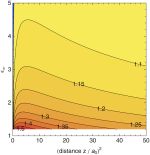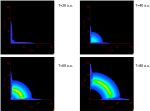News
EPJ A has a new Editor in Chief for experimental physics
- Details
- Published on 11 January 2013

From January 2013 Nicolas Alamanos succeeds Enzo De Sanctis as Editor in Chief of EPJ A for the experimental physics section.
Professor Alamanos is Deputy Director of the Institute of Research into the Fundamental Laws of the Universe (IRFU) and Research Director at CEA Saclay working in the domain of fundamental research in Nuclear Physics. During his long scientific career, he has served on many scientific and program advisory committees and has occupied different managerial positions. Most notably he has been president of GANIL’s scientific council and director of Saclay Nuclear Physics Division. He is a member or evaluator of many national committees – ARISTEIA (GRECE), FRS-FNRS (Belgium), ANR (France). He is currently a member of the GANIL/SPIRAL2 scientific council, of GANIL’s program advisory committee, and scientific counselor of the European program “CEA-Euro talents” in the domain of high energy physics and physics of the universe.
In addition to his various scientific and administrative duties, Professor Alamanos has always been very active editorially: beyond having been a member of the editorial board of EPJ A for many years, he is the Editor of the Scholarpedia Encyclopedia of Nuclear Physics.
EPJ D Highlight - May the force be with the atomic probe
- Details
- Published on 10 January 2013

New models suggest devising means of probing a surface at a sub-micrometric level as this will help us understand how electrons’ diffusion affects long-range attractive forces
Theoretical physicist Elad Eizner from Ben Gurion University, Israel, and colleagues created models to study the attractive forces affecting atoms located at a wide range of distances from a surface, in the hundreds of nanometers range. Their results, just published in EPJ D, show that these forces depend on electron diffusion, regardless of whether the surface is conducting or not. Ultimately, these findings could contribute to designing minimally invasive surface probes.
EPJ B Highlight - Silver Sheds Light On Superconductor Secrets
- Details
- Published on 10 January 2013

By doping a bismuth-based layered material with silver, Chinese scientists demonstrated that superconductivity is intrinsic to the new material rather than stemming from its impurities
The first report on the chemical substitution, or doping, using silver atoms, for a new class of superconductor that was only discovered this year, has just been published in EPJ B. Chinese scientists from Institute of Solid State Physics, Chinese Academy of Sciences, Hefei, discovered that the superconductivity is intrinsic rather than created by impurities in this material with a sandwich-style layered structure made of bismuth oxysulphide (Bi4O4S3).
EPJ E Highlight - Adhesion disturbed by noise
- Details
- Published on 20 December 2012

A new model could ultimately help robotic fingers, made of a soft surface, manipulate small objects
Imagine a solid ball rolling down a slightly inclined ramp. What could be perceived as child’s play is the focus of serious theoretical research by Manoj Chaudhury and Partho Goohpattader, two physicists from Lehigh University, Bethlehem, Pensylvania, USA. Their study, which has just been published in EPJ E, has one thing in common with childhood behaviour. It introduces a mischievous idea, namely studying the effect of random noise, such as vibrations, on the ball. They found it could lower the energy barrier to set the ball in motion.
EPJ Data Science Highlight - Tracking gene flow in marine plant evolution
- Details
- Published on 20 December 2012

Physicists and biologists apply Big Data statistical tools to study marine plant evolution
A new method that could give a deeper insight into evolutional biology by tracing directionality in gene migration has just appeared in EPJ Data Science. Paolo Masucci from the Centre for Advanced Spatial Analysis, at University College of London, UK, and colleagues identified the segregation of genes that a marine plant underwent during its evolution. They found that the exchange of genes, or gene flow, between populations of a marine plant went westward from the Mediterranean to the Atlantic. This methodology could also be used to estimate the information flow in complex networks, including other biological or social networks.
EPJ C Highlight - Curvature Oscillations in Modified Gravity Theories as Possible Source of Ultra-High-Energy Cosmic Rays
- Details
- Published on 07 December 2012
The origin of ultra-high-energy cosmic rays, with energies around the GZK cutoff, remains an unsolved mystery. In the present letter a novel and intriguing explanation is suggested that links far-reaching fundamental aspects of F(R) modified theories to an efficient production of highly energetic cosmic rays during the recent history of the Universe.
At the core of this work lies the proof that in cosmological and astrophysical systems with rising energy densities, the F(R) modified theories of gravity exhibit powerful oscillations of the curvature scalar R, with an amplitude much larger than the standard value of curvature predicted by the General Relativity. These oscillations are strongly anharmonic, with frequencies that can be as large as billions of GeV. This striking and rather unexpected oscillatory behavior of R lends support to the idea that ultra-high energy cosmic rays can be generated by such curvature oscillations at the appropriate cosmological redshifts.
Curvature oscillations in modified gravity and high energy cosmic rays. E.V. Arbuzova, A.D. Dolgov, L. Reverberi (2012), European Physical Journal C 72:2247, DOI 10.1140/epjc/s10052-012-2247-z
EPJ D Colloquium – An accurate method to measure scattering non-perturbatively
- Details
- Published on 26 November 2012

Atomic and molecular collisions occurring at low impact energies and for neutral targets need adequate methods for accurately measuring their scattering properties. Such measures are fundamental to the description of the dynamics of plasmas and provide insight into the long-range Coulomb interactions between charged particles. In the last twenty years many novel non-perturbative approaches have been applied. The time-dependent close-coupling (TDCC) approach, discussed in this EPJD Review, differs fundamentally from previous non-perturbative approaches in that it solves the time-dependent, rather than time-independent, Schr¨odinger equation. This Review provides a detailed description of the application of the time-dependent close-coupling approach to ionising collisions of electrons, photons and ions with small atoms and molecules.
EPJ D Highlight - Bringing measuring accuracy to radical treatment
- Details
- Published on 13 November 2012

Significant progress made in evaluating the density of active species used in medical applications of plasma physics could improve the accuracy of treatment
An international team of scientists working at the Plasma Technology research unit at Ghent University, Belgium, has determined for the first time the absolute density of active substances called radicals found in a state of matter known as plasma, in a study just published in EPJ D. These findings could have important implications for medicine—for example, for stimulating tissue regeneration, or to induce a targeted antiseptic effect in vivo without affecting neighbouring tissues.
Hyperlinked references
- Details
- Published on 13 November 2012
EPJ Web of Conferences now provides online references, which are directly linked to the cited articles, via CrossRef. This allows the readers to move from one article to another at the citation level, regardless of journal or publisher.
EPJ Web of Conferences also provides a citation tracking system.
EPJ Web of Conferences adopts the Creative Commons Attribution License
- Details
- Published on 13 November 2012
Up to now, EPJ Web of Conferences contents were published under the Creative Commons Attribution Non-Commercial license. We are pleased to announce that the journal won’t restrict the commercial use of its contents any more. As a result, all open access contents at EPJ Web of Conferences will be published under the Creative Commons Attribution license, which permits unrestricted use, distribution, and reproduction in any medium, provided the original work is properly cited. The copyright will remain with the authors.




